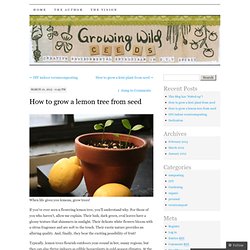

How to Plant an Avocado Tree: 16 Steps. Some growers find that placing the seed in water to sprout it risks producing a long, leggy tree that fails to fruit.

In this case, it is better to place the seed in the ground without soaking first. 1Obtain a good quality avocado fruit. Cut the fruit flesh away from the seed. It is easiest to cut it the long way around. 2Twist the seed to remove it. Whack it with a knife, then twist, and the seed will come out. 3Find the pointed end of the seed. this is the top of the seed. 4Choose a planting locale. BRAVEHEARTED BEAUTY: Details Of Our First-Ever Garden. Considering the way we eat, it makes sense that we would enjoy growing our own food, but I didn't know just how much until now.

My whole family is enthralled with our new garden! We can't stop admiring it! The best part: we all worked together! I read several books and talked about a vegetable garden for years, but my list of excuses was long until my husband said, "Let's do this thing! " {When he's in the mood, I've learned to take him up on it. So when I saw these great looking plants at Whole Foods last week, I brought them home.
The beginnings of a perfect salad garden: mixed lettuces, radicchio, spinach, ping pong radishes and cupid tomatoes. But where to plant them? Problem 1: Our back "yard" is more like a courtyard. Problem 2: Not enough sunlight. Problem 3: We have a tailored, tidy landscape style {and interior design style...who am I kidding?}. Behold the neat and tidy garden! {An aerial view of our new garden.} Looks like we solved all of our "problems! " {I'm blushing!} How to Make Your Own Herb Garden - Snapguide. How to grow a lemon tree from seed. When life gives you lemons, grow trees!

If you’ve ever seen a flowering lemon tree, you’ll understand why. For those of you who haven’t, allow me explain. Their lush, dark green, oval leaves have a glossy texture that shimmers in sunlight. Their delicate white flowers bloom with a citrus fragrance and are soft to the touch. Their exotic nature provides an alluring quality. Typically, lemon trees flourish outdoors year-round in hot, sunny regions, but they can also thrive indoors as edible houseplants in cold-season climates. This is the little tree with big fruit in the shop I work at. And while rooting cuttings is a sensible option for fast fruit, lemon tree cuttings are not readily available in many parts of the world.
Here is a step-by-step guide to growing your very own lemon tree from seed: How to Grow Garlic. Did you know that one clove or bulb of garlic, when planted, can produce up to an additional twenty cloves?

So instead of tossing out your garlic that’s started to sprout, plant it instead! Simply plant garlic cloves individually. If they’ve started to sprout, even better! Otherwise plant them with the pointy end up. Make sure they are in a sunny location and soil isn’t too damp. Then just sit back and wait for your garlic to grow. Once you harvest your garlic, hang the bulbs in a cool, dry location to dry them and prevent rot. The handmade pottery pot photographed above that I used for planting my garlic bulb was purchased from Roanoke Pottery Works on the Roanoke City Market. The Easiest Vegetables to Grow. Let’s face it: Some crops are just easier to grow than others.

If you’re new to growing food, you might want to keep it simple and stick with options that are sure to leave you feeling successful at the end of your first official growing season. These options offer great odds and are some of the easiest vegetables to grow. Unless otherwise noted, these crops can easily be direct seeded in the garden. Cool season veggies can generally be planted in Spring as soon as the soil can be worked and again in the Fall. They don’t do so well during the hot months of Summer. Radish: They sprout easily and quickly, and can be harvested in just three to four weeks. Arugula: This spicy green grows easily in pots. Snow pea and/or sugar snap pea: Snow peas have edible pods and should be harvested just as you can see the seeds forming inside for the most tender crop.
Swiss chard: Grown for both its greens and the stalks, Swiss chard is easy to grow and it can be continuously harvested for months.